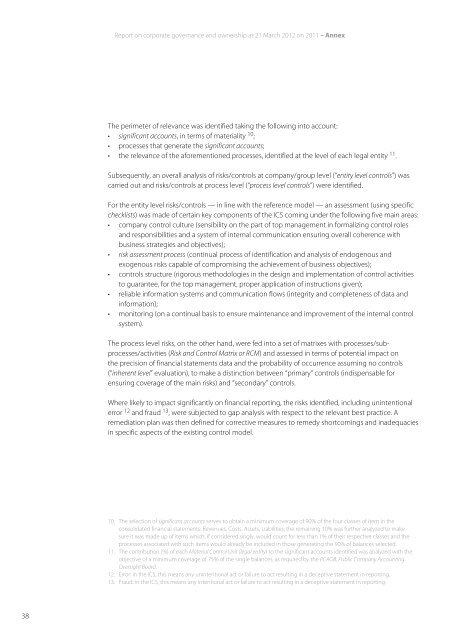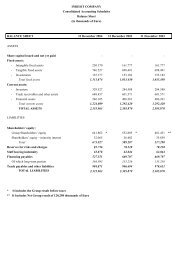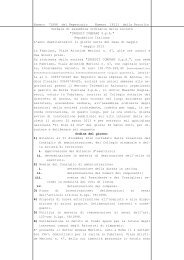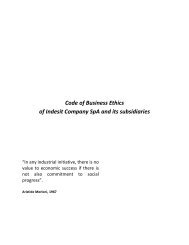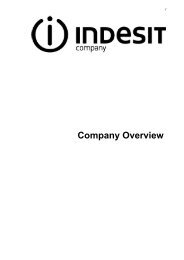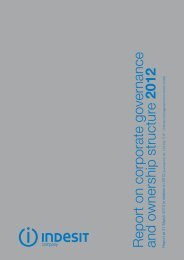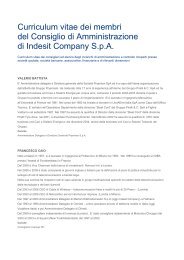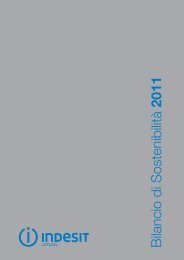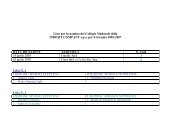Report on corporate governance and ownership 2011 - Indesit
Report on corporate governance and ownership 2011 - Indesit
Report on corporate governance and ownership 2011 - Indesit
You also want an ePaper? Increase the reach of your titles
YUMPU automatically turns print PDFs into web optimized ePapers that Google loves.
<br />
<str<strong>on</strong>g>Report</str<strong>on</strong>g> <strong>on</strong> <strong>corporate</strong> <strong>governance</strong> <strong>and</strong> <strong>ownership</strong> at 21 March 2012 <strong>on</strong> <strong>2011</strong> – Annex<br />
The perimeter of relevance was identified taking the following into account:<br />
• significant accounts, in terms of materiality 10 ;<br />
• processes that generate the significant accounts;<br />
• the relevance of the aforementi<strong>on</strong>ed processes, identified at the level of each legal entity 11 .<br />
Subsequently, an overall analysis of risks/c<strong>on</strong>trols at company/group level (“entity level c<strong>on</strong>trols”) was<br />
carried out <strong>and</strong> risks/c<strong>on</strong>trols at process level (“process level c<strong>on</strong>trols”) were identified.<br />
For the entity level risks/c<strong>on</strong>trols — in line with the reference model — an assessment (using specific<br />
checklists) was made of certain key comp<strong>on</strong>ents of the ICS coming under the following five main areas:<br />
• company c<strong>on</strong>trol culture (sensibility <strong>on</strong> the part of top management in formalizing c<strong>on</strong>trol roles<br />
<strong>and</strong> resp<strong>on</strong>sibilities <strong>and</strong> a system of internal communicati<strong>on</strong> ensuring overall coherence with<br />
business strategies <strong>and</strong> objectives);<br />
• risk assessment process (c<strong>on</strong>tinual process of identificati<strong>on</strong> <strong>and</strong> analysis of endogenous <strong>and</strong><br />
exogenous risks capable of compromising the achievement of business objectives);<br />
• c<strong>on</strong>trols structure (rigorous methodologies in the design <strong>and</strong> implementati<strong>on</strong> of c<strong>on</strong>trol activities<br />
to guarantee, for the top management, proper applicati<strong>on</strong> of instructi<strong>on</strong>s given);<br />
• reliable informati<strong>on</strong> systems <strong>and</strong> communicati<strong>on</strong> flows (integrity <strong>and</strong> completeness of data <strong>and</strong><br />
informati<strong>on</strong>);<br />
• m<strong>on</strong>itoring (<strong>on</strong> a c<strong>on</strong>tinual basis to ensure maintenance <strong>and</strong> improvement of the internal c<strong>on</strong>trol<br />
system).<br />
The process level risks, <strong>on</strong> the other h<strong>and</strong>, were fed into a set of matrixes with processes/subprocesses/activities<br />
(Risk <strong>and</strong> C<strong>on</strong>trol Matrix or RCM) <strong>and</strong> assessed in terms of potential impact <strong>on</strong><br />
the precisi<strong>on</strong> of financial statements data <strong>and</strong> the probability of occurrence assuming no c<strong>on</strong>trols<br />
(“inherent level” evaluati<strong>on</strong>), to make a distincti<strong>on</strong> between “primary” c<strong>on</strong>trols (indispensable for<br />
ensuring coverage of the main risks) <strong>and</strong> “sec<strong>on</strong>dary” c<strong>on</strong>trols.<br />
Where likely to impact significantly <strong>on</strong> financial reporting, the risks identified, including unintenti<strong>on</strong>al<br />
error 12 <strong>and</strong> fraud 13 , were subjected to gap analysis with respect to the relevant best practice. A<br />
remediati<strong>on</strong> plan was then defined for corrective measures to remedy shortcomings <strong>and</strong> inadequacies<br />
in specific aspects of the existing c<strong>on</strong>trol model.<br />
10. The selecti<strong>on</strong> of significant accounts serves to obtain a minimum coverage of 90% of the four classes of item in the<br />
c<strong>on</strong>solidated financial statements: Revenues, Costs, Assets, Liabilities; the remaining 10% was further analyzed to make<br />
sure it was made up of items which, if c<strong>on</strong>sidered singly, would count for less than 1% of their respective classes <strong>and</strong> the<br />
processes associated with such items would already be included in those generating the 90% of balances selected.<br />
11. The c<strong>on</strong>tributi<strong>on</strong> (%) of each Material C<strong>on</strong>trol Unit (legal entity) to the significant accounts identified was analyzed with the<br />
objective of a minimum coverage of 75% of the single balances, as required by the PCAOB, Public Company Accounting<br />
Oversight Board.<br />
12. Error: in the ICS, this means any unintenti<strong>on</strong>al act or failure to act resulting in a deceptive statement in reporting.<br />
13. Fraud: in the ICS, this means any intenti<strong>on</strong>al act or failure to act resulting in a deceptive statement in reporting.<br />
38


